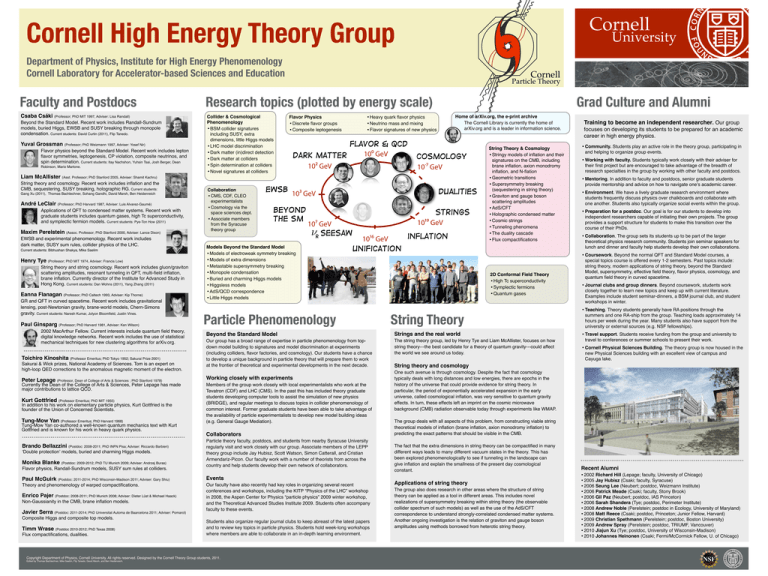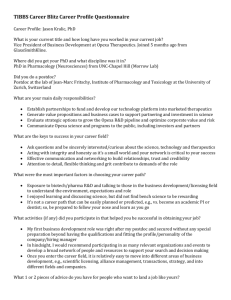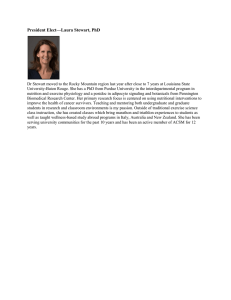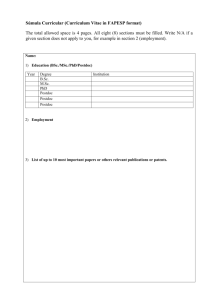
Cornell
Cornell High Energy Theory Group
University
Department of Physics, Institute for High Energy Phenomenology
Cornell Laboratory for Accelerator-based Sciences and Education
Faculty and Postdocs
Research topics (plotted by energy scale)
Csaba Csáki (Professor; PhD MIT 1997, Adviser: Lisa Randall)
Collider & Cosmological
Phenomenology
• BSM collider signatures
including SUSY, extra
dimensions, little Higgs models
• LHC model discrimination
• Dark matter (in)direct detection
• Dark matter at colliders
• Spin determination at colliders
• Novel signatures at colliders
Beyond the Standard Model. Recent work includes Randall-Sundrum
models, buried Higgs, EWSB and SUSY breaking through monopole
condensation. Current students: David Curtin (2011), Flip Tanedo.
Yuval Grossman (Professor; PhD Weizmann 1997, Adviser: Yosef Nir)
Flavor physics beyond the Standard Model. Recent work includes lepton
flavor symmetries, leptogenesis, CP violation, composite neutrinos, and
spin determination. Current students: Itay Nachshon, Yuhsin Tsai, Josh Berger, Dean
Robinson, Mario Martone.
Liam McAllister (Asst. Professor; PhD Stanford 2005, Adviser: Shamit Kachru)
String theory and cosmology. Recent work includes inflation and the
CMB, sequestering, SUSY breaking, holographic RG. Current students:
Gang Xu (2011), Thomas Bachlechner, Sohang Gandhi, David Marsh, Ben Heidenreich
André LeClair (Professor; PhD Harvard 1987, Adviser: Luis Alvarez-Gaumé)
Applications of QFT to condensed matter systems. Recent work with
graduate students includes quantum gases, high Tc superconductivity,
and symplectic fermion models. Current students: Pye-Ton How (2011)
Maxim Perelstein (Assoc. Professor; PhD Stanford 2000, Adviser: Lance Dixon)
EWSB and experimental phenomenology. Recent work includes
dark matter, SUSY sum rules, collider physics of the LHC.
Current students: Bibhushan Shakya, Mike Saelim
Henry Tye (Professor; PhD MIT 1974, Adviser: Francis Low)
String theory and string cosmology. Recent work includes gluon/graviton
scattering amplitudes, resonant tunneling in QFT, multi-field inflation,
brane inflation. Currently director of the Institute for Advanced Study in
Hong Kong. Current students: Dan Wohns (2011), Yang Zhang (2011)
Eanna Flanagan (Professor; PhD Caltech 1993, Adviser: Kip Thorne)
GR and QFT in curved spacetime. Recent work includes gravitational
lensing, post-Newtonian gravity, brane-world models, Chern-Simons
gravity. Current students: Naresh Kumar, Jolyon Bloomfield, Justin Vines.
Paul Ginsparg (Professor; PhD Harvard 1981, Adviser: Ken Wilson)
2002 MacArthur Fellow. Current interests include quantum field theory,
digital knowledge networks. Recent work includes the use of statistical
mechanical techniques for new clustering algorithms for arXiv.org.
Toichiro Kinoshita (Professor Emeritus; PhD Tokyo 1952; Sakurai Prize 2001)
Sakurai & Wick prizes, National Academy of Sciences. Tom is an expert on
high-loop QED corrections to the anomalous magnetic moment of the electron.
Peter Lepage (Professor, Dean of College of Arts & Sciences ; PhD Stanford 1978)
Currently the Dean of the College of Arts & Sciences, Peter Lepage has made
major contributions to lattice QCD.
Kurt Gottfried (Professor Emeritus; PhD MIT 1955)
In addition to his work on elementary particle physics, Kurt Gottfried is the
founder of the Union of Concerned Scientists.
Tung-Mow Yan (Professor Emeritus; PhD Harvard 1968)
Tung-Mow Yan co-authored a well-known quantum mechanics text with Kurt
Gottfried and is known for his work in heavy quark physics.
Brando Bellazzini (Postdoc: 2008-2011; PhD INFN Pisa; Adviser: Riccardo Barbieri)
"Double protection! models, buried and charming Higgs models.
Monika Blanke (Postdoc: 2009-2012; PhD TU Munich 2009; Adviser: Andrzej Buras)
Flavor physics, Randall-Sundrum models, SUSY sum rules at colliders.
Collaboration
• CMS, CDF, CLEO
experimentalists
• Cosmology via the
space sciences dept.
• Associate members
from the Syracuse
theory group
EWSB
Flavor Physics
• Discrete flavor groups
• Composite leptogenesis
Models Beyond the Standard Model
• Models of electroweak symmetry breaking
• Models of extra dimensions
• Metastable supersymmetry breaking
• Monopole condensation
• Buried and charming Higgs models
• Higgsless models
• AdS/QCD correspondence
• Little Higgs models
strings
1019 GeV
1016 GeV
unification
Particle Phenomenology
Members of the group work closely with local experimentalists who work at the
Tevatron (CDF) and LHC (CMS). In the past this has included theory graduate
students developing computer tools to assist the simulation of new physics
(BRIDGE), and regular meetings to discuss topics in collider phenomenology of
common interest. Former graduate students have been able to take advantage of
the availability of particle experimentalists to develop new model building ideas
(e.g. General Gauge Mediation).
Collaborators
Particle theory faculty, postdocs, and students from nearby Syracuse University
regularly visit and work closely with our group. Associate members of the LEPP
theory group include Jay Hubisz, Scott Watson, Simon Catterall, and Cristian
Armendariz-Picon. Our faculty work with a number of theorists from across the
country and help students develop their own network of collaborators.
Our faculty have also recently had key roles in organizing several recent
conferences and workshops, including the KITP “Physics of the LHC” workshop
in 2008, the Aspen Center for Physics “particle physics” 2009 winter workshop,
and the Theoretical Advanced Studies Institute 2009. Students often accompany
faculty to these events.
Composite Higgs and composite top models.
Timm Wrase (Postdoc 2010-2012; PhD Texas 2008)
Flux compactifications, dualities.
Students also organize regular journal clubs to keep abreast of the latest papers
and to review key topics in particle physics. Students hold week-long workshops
where members are able to collaborate in an in-depth learning environment.
Copyright Department of Physics, Cornell University. All rights reserved. Designed by the Cornell Theory Group students, 2011.
Edited by Thomas Bachlechner, Mike Saelim, Flip Tanedo, David Marsh, and Ben Heidenreich.
String Theory
The string theory group, led by Henry Tye and Liam McAllister, focuses on how
string theory---the best candidate for a theory of quantum gravity---could affect
the world we see around us today.
Theory and phenomenology of warped compactifications.
Javier Serra (Postdoc: 2011-2014; PhD Universitat Automa de Baarcelona 2011; Adviser: Pomarol)
2D Conformal Field Theory
• High Tc superconductivity
• Symplectic fermions
• Quantum gases
Our group has a broad range of expertise in particle phenomenology from topdown model building to signatures and model discrimination at experiments
(including colliders, flavor factories, and cosmology). Our students have a chance
to develop a unique background in particle theory that will prepare them to work
at the frontier of theoretical and experimental developments in the next decade.
Working closely with experiments
Training to become an independent researcher. Our group
focuses on developing its students to be prepared for an academic
career in high energy physics.
• Community. Students play an active role in the theory group, participating in
and helping to organize group events.
• Working with faculty. Students typically work closely with their adviser for
their first project but are encouraged to take advantage of the breadth of
research specialties in the group by working with other faculty and postdocs.
• Mentoring. In addition to faculty and postdocs, senior graduate students
provide mentorship and advice on how to navigate one!s academic career.
• Environment. We have a lively graduate research environment where
students frequently discuss physics over chalkboards and collaborate with
one another. Students also typically organize social events within the group.
• Preparation for a postdoc. Our goal is for our students to develop into
independent researchers capable of initiating their own projects. The group
provides a support structure for students to make this transition over the
course of their PhDs.
• Collaboration. The group sets its students up to be part of the larger
theoretical physics research community. Students join seminar speakers for
lunch and dinner and faculty help students develop their own collaborations.
• Coursework. Beyond the normal QFT and Standard Model courses, a
Strings and the real world
Events
Non-Gaussianity in the CMB, brane inflation models.
inflation
String Theory & Cosmology
• Stringy models of inflation and their
signatures on the CMB, including
brane inflation, axion monodromy
inflation, and N-flation
• Geometric transitions
• Supersymmetry breaking
(sequestering in string theory)
• Graviton and gauge boson
scattering amplitudes
• AdS/CFT
• Holographic condensed matter
• Cosmic strings
• Tunneling phenomena
• The duality cascade
• Flux compactifications
Beyond the Standard Model
Paul McGuirk (Postdoc: 2011-2014; PhD Wisconsin-Madison 2011; Adviser: Gary Shiu)
Enrico Pajer (Postdoc: 2008-2011; PhD Munich 2008; Adviser: Dieter Lüst & Michael Haack)
cosmology
10-7 GeV
dualities
103 GeV
107 GeV
νr seesaw
! mass
Home of arXiv.org, the e-print archive
The Cornell Library is currently the home of
arXiv.org and is a leader in information science.
• Heavy quark flavor physics
• Neutrino mass and mixing
• Flavor signatures of new physics
flavor & qcd
100 GeV
dark matter
102 GeV
beyond
the sm
Grad Culture and Alumni
special topics course is offered every 1-2 semesters. Past topics include:
string theory, modern applications of string theory, beyond the Standard
Model, supersymmetry, effective field theory, flavor physics, cosmology, and
quantum field theory in curved spacetime.
• Journal clubs and group dinners. Beyond coursework, students work
closely together to learn new topics and keep up with current literature.
Examples include student seminar-dinners, a BSM journal club, and student
workshops in winter.
• Teaching. Theory students generally have RA positions through the
summers and one RA-ship from the group. Teaching loads approximately 14
hours per week during the year. Many students also have support from the
university or external sources (e.g. NSF fellowships).
• Travel support. Students receive funding from the group and university to
travel to conferences or summer schools to present their work.
• Cornell Physical Sciences Building. The theory group is now housed in the
new Physical Sciences building with an excellent view of campus and
Cayuga lake.
String theory and cosmology
One such avenue is through cosmology. Despite the fact that cosmology
typically deals with long distances and low energies, there are epochs in the
history of the universe that could provide evidence for string theory. In
particular, the period of exponentially accelerated expansion in the early
universe, called cosmological inflation, was very sensitive to quantum gravity
effects. In turn, these effects left an imprint on the cosmic microwave
background (CMB) radiation observable today through experiments like WMAP.
The group deals with all aspects of this problem, from constructing viable string
theoretical models of inflation (brane inflation, axion monodromy inflation) to
predicting the exact patterns that should be visible in the CMB.
The fact that the extra dimensions in string theory can be compactified in many
different ways leads to many different vacuum states in the theory. This has
been explored phenomenologically to see if tunneling in the landscape can
give inflation and explain the smallness of the present day cosmological
constant.
Applications of string theory
The group also does research in other areas where the structure of string
theory can be applied as a tool in different areas. This includes novel
realizations of supersymmetry breaking within string theory (the observable
collider spectrum of such models) as well as the use of the AdS/CFT
correspondence to understand strongly-correlated condensed matter systems.
Another ongoing investigation is the relation of graviton and gauge boson
amplitudes using methods borrowed from heterotic string theory.
Recent Alumni
• 2002 Richard Hill (Lepage; faculty, University of Chicago)
• 2005 Jay Hubisz (Csaki; faculty, Syracuse)
• 2006 Seung Lee (Neubert; postdoc, Weizmann Institute)
• 2006 Patrick Meade (Csaki; faculty, Stony Brook)
• 2006 Gil Paz (Neubert; postdoc, IAS Princeton)
• 2006 Sarah Shandera (Tye; postdoc, Perimeter Institute)
• 2008 Andrew Noble (Perelstein; postdoc in Ecology, University of Maryland)
• 2008 Matt Reece (Csaki; postdoc, Princeton; Junior Fellow, Harvard)
• 2009 Christian Spethmann (Perelstein; postdoc, Boston University)
• 2009 Andrew Spray (Perelstein; postdoc, TRIUMF, Vancouver)
• 2010 Jiajun Xu (Tye; postdoc, University of Wisconsin-Madison)
• 2010 Johannes Heinonen (Csaki; Fermi/McCormick Fellow, U. of Chicago)



